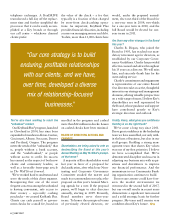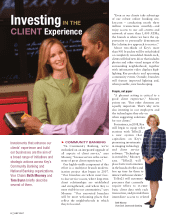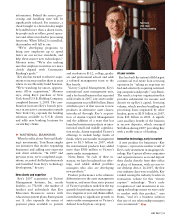KeyBank 2007 Annual Report Download - page 18
Download and view the complete annual report
Please find page 18 of the 2007 KeyBank annual report below. You can navigate through the pages in the report by either clicking on the pages listed below, or by using the keyword search tool below to find specific information within the annual report.16
MANAGEMENT’S DISCUSSION & ANALYSIS OF FINANCIAL CONDITION & RESULTS OF OPERATIONS KEYCORP AND SUBSIDIARIES
Corporate strategy
The strategy for achieving Key’s long-term goals includes the following
six primary elements:
•Focus on core businesses. We concentrate on businesses that enable
Key to build client relationships. We focus on our “footprint”
operations (i.e., businesses conducted primarily within the states
that have branches) that serve individuals, small businesses and
middle market companies. In addition, we focus nationwide on
businesses such as commercial real estate activities, investment
management and equipment leasing. Management believes Key
possesses resources of the scale necessary to compete nationally in the
market for these services.
•Build relationships. We work to deepen relationships with existing
clients and to build relationships with new clients, particularly those
that have the potential to purchase multiple products and services or
to generate repeat business. To that end, we emphasize deposit
growth across all lines of business. We also put considerable effort into
enhancing service quality.
•Enhance our business. We strive for continuous improvement in
Key’s businesses. We continue to focus on increasing revenues,
controlling expenses and maintaining the credit quality of Key’s
loan portfolios. We intend to continue to leverage technology to
achieve these objectives.
•Cultivate a workforce that demonstrates Key’s values and works
together for a common purpose. We intend to achieve this by:
— attracting, developing and retaining a talented, high-performing and
inclusive workforce;
— developing leadership at all staff and management levels;
— creating a positive, stimulating and client-focused work environ-
ment; and
— compensating for performance achieved in ways that are consistent
with Key’s values.
•Enhance performance measurement. We intend to refine and to
enhance our utilization of performance measurement mechanisms that
help ensure that Key is maximizing shareholder returns and that
those returns are appropriate considering the inherent levels of risk
involved. We will strive to craft incentive compensation plans that
reward the contributions employees make to profitability.
•Manage capital effectively. We intend to continue to manage Key’s
equity capital effectively by paying dividends to shareholders,
repurchasing Key common shares in the open market or through
privately-negotiated transactions, and investing in our businesses.
Economic overview
Economic growth in the United States as measured by the Gross
Domestic Product (“GDP”) averaged 3.1% during the first three
quarters of 2007. This exceeded the 2006 average of 2.6% and the ten-
year average of 2.8%. During 2007, the economy added an average of
111,000 new jobs per month to the nation’s employment levels. The
unemployment rate averaged 4.6% during 2007, unchanged from the
prior year. Consumer prices rose 4.1%, the largest increase since 1990,
reflecting increases in food, energy and medical costs. During the
second half of 2007, concerns began to grow that economic pressures
caused by the deteriorating housing sector would extend to the broader
economy and cause consumer and capital spending to decline, adversely
affecting the GDP and job growth in 2008. The benchmark ten-year
Treasury yield began 2007 at 4.70% and finished the year at 4.02%. The
two-year Treasury yield began 2007 at 4.81% and closed the year at
3.05%. During 2007, the banking industry, including Key, continued to
experience commercial and industrial loan growth.
During the second half of 2007, the U.S. economy was adversely
affected by continued deterioration in the housing market and
extraordinary volatility in the fixed income markets. New home sales
declined by 41% nationally, median home prices of existing homes fell
by more than 5% and defaults on subprime mortgage loans rose
significantly as adjustable-rate mortgages reset higher and housing
became less affordable. In addition, the widening of credit spreads in
the fixed income markets adversely affected the market values at
which loans held for sale, trading portfolios and certain investments are
recorded. These problems affected Key’s 2007 results in varying
degrees. Certain geographic regions were hit harder than others and this
had some influence on the regional business conducted by the
Community Banking group and the national commercial real estate
lending business conducted by the National Banking group, particularly
in Florida and southern California.
Declines in new home sales for 2007 by geographic regions as defined
by the U.S. Department of Commerce were as follows: Northeast —
27%, Midwest — 56%, West — 43% and South — 36%. This
information provides some indication of the extent to which Key’s
business may have been affected by the state of the economy in the
regions in which the Community and National Banking groups operate.
Further information pertaining to Key’s geographic exposure is included
in the “Demographics” section on page 17.
Losses caused by disruption in the credit and fixed income markets have
put capital levels at many banks under pressure, resulting in a tightening
of lending standards and terms. With the news of subprime losses, the
London Interbank Offered Rate increased, thereby causing a dramatic
rise in the cost of both short and long-term credit. As a result, investors
relied more heavily on high quality U.S. Treasury obligations, pushing
the yields for these securities down during the second half of 2007. In
response, the Federal Reserve lowered the federal funds target rate
from 5.25% to 4.25% during the last four months of 2007, and further
reduced the rate to 3.00% in January 2008. In addition, the Federal
Reserve acted to boost investor confidence by injecting liquidity into the
short-term money markets.
For regional banks such as Key, access to the markets for unsecured term
debt was severely restricted during the second half of 2007, with
investors requiring much wider spreads over risk-free U.S. Treasury
obligations to make new investments. Regional and money center
banks also experienced reduced liquidity and elevated costs for 30-day
money market borrowings between financial institutions. For this and
other reasons, in December 2007 the Federal Reserve introduced the
Term Auction Facility (“TAF”) program to provide additional funding
for financial institutions.
























